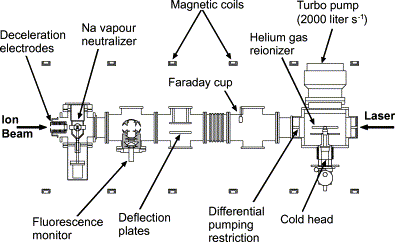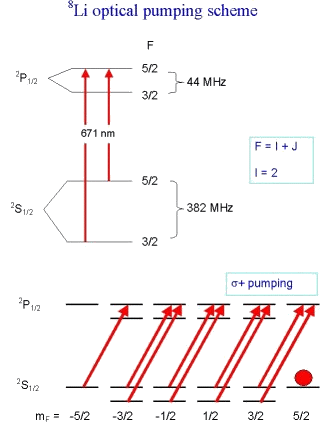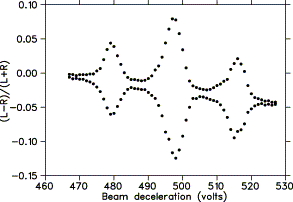
The ISAC β-NMR HomePage
| Introduction to β-NMR |
Publications |
Students Projects |
Contacts |
| Technical Information |
Data Acquistion |
Approved Experiments |
Internal Page |
| Related Links |
BNMR Wiki |
Data Analysis |
Photo Album |
|
|
Optical Polarization for β-NMR at ISAC
In conventional NMR experiments, nuclear spins are polarized by a large static magnetic field. In the β-NMR apparatus at ISAC nuclear polarization is produced in the ion beam in flight via optical pumping with circularly polarized laser light. The polarizer relies on the well known technique, developed for many years at CERN's ISOLDE, of collinear optical pumping to highly polarize the nuclear spins of 10–60 keV radioactive beams. At ISAC, alkali-metal beams are longitudinally polarized through optical pumping of a fast atomic beam, which is created with up to 90% efficiency by charge exchange of the incident ion beam in a Na vapour jet (see Fig. 1). The polarized beam is then reionized in a cold He gas target with 66% efficiency and directed to the experiments.
Fig. 1. Details of the collinear optically pumped polarizer.
Reionizing the
beam gives some important advantages, enabling the use of electrostatic
optics to steer and focus the beam into several experiments. Two or
more
experiments may run simultaneously in the future by sharing the beam
using a fast kicker. The beam energy, and hence implantation depth, is
varied at the existing condensed matter experimental station from a few
hundred eV to 60 keV, by biasing the target. Post-polarization
electrostatic bends isolate the experiments from the Na vapour and
laser light in the polarizer. The polarization direction (longitudinal
or transverse with respect to the beam momentum) is determined by the
number of electrostatic 90° bends. A polarimeter measures the
transverse polarization of the ion beam after it has been
electrostatically deflected by 90°, and a second polarimeter is
being built to measure the longitudinal polarization of the undeflected
fast atomic beam. To date, 30 keV polarized beams of 8Li+
(over 107 ions s-1 at the experiment) and 9Li+
(105 ions s-1) have been produced at ISAC.
The 8Li
beam is polarized by optical pumping on the D1
transition with counter-propagating circularly polarized light. 8Li
has two ground state hyperfine levels, in common with most alkali-metal
isotopes, that in this case are split by 382 MHz (see Fig.
2). Both levels must be pumped in order to achieve high
polarization. The optical pumping laser is an argon-ion laser pumped,
standing wave Spectra-Physics 3900S Ti:sapphire (TiS) laser, specially
modified to lase at the two required frequencies at 673 nm. This is
very
near the short wavelength limit of TiS, and is achieved with a rear
cavity mirror centred at 650 nm and an R=99% output coupler.
The cavity length is shortened to increase the longitudinal mode
spacing to 381 MHz. A 1 mm thick, R=10% intra-cavity etalon
ensures operation on only two neighboring modes. The crystal gain
medium is in the centre of the cavity, where the nodes of one mode
coincide with the anti-nodes of the other, minimizing gain competition
and ensuring simultaneous oscillation of both modes. Typical laser
power
is ~100 mW on each mode. The linewidth of each mode is ~1 MHz on
timescales comparable to the 2  s transit
time of the atoms in the
optical pumping region. Vibrational instability causes frequency
fluctuations over a range of ±20 MHz on much longer timescales.
Doppler-shift tuning onto resonance is done by varying the deceleration
potential on the Na cell between 0 and 1 kV, thus scanning the beam
energy, while keeping the laser frequencies fixed. The tuning peak is
found by measuring the polarization at the polarimeter, or observing
the
laser induced fluorescence in the optical pumping region. The laser
frequencies are prevented from drifting more than ±3 MHz per day
by a system based on a frequency stabilized He–Ne laser.
s transit
time of the atoms in the
optical pumping region. Vibrational instability causes frequency
fluctuations over a range of ±20 MHz on much longer timescales.
Doppler-shift tuning onto resonance is done by varying the deceleration
potential on the Na cell between 0 and 1 kV, thus scanning the beam
energy, while keeping the laser frequencies fixed. The tuning peak is
found by measuring the polarization at the polarimeter, or observing
the
laser induced fluorescence in the optical pumping region. The laser
frequencies are prevented from drifting more than ±3 MHz per day
by a system based on a frequency stabilized He–Ne laser.
| Fig. 2. A scheme of the atomic levels of 8Li. The upper part of the figure shows the hyperfine splittings in the ground state and 1st excited state of 8Li, along with the pumping transitions. The lower part shows the nearly degenerate Zeeman splitting of the hyperfine levels into 2F+1 magnetic sublevels m_F. Optical pumping with sigma+ light is shown, in which the only allowed absorptions are those having an increase of angular momentum +1, Delta m_F = +1. Fluorescence can occur on transitions satisfying Delta m_F = 0, +/-1. After many cycles of optical pumping, all the atoms end up in the fully stretched state m_F = 5/2, with full nuclear and electronic polarization, shown by the red circle. Once in that state, they cannot be pumped out of it by the laser light. The luorescence lifetime is 27 ns, which allows for approximately 20 optical pumping cycles in the 2 us transit time of atoms through the polarizer. Pumping with sigma- light pumps all the atoms into the m_F = -5/2 ground state. |
The key to achieving high polarization is to match the optical pumping light bandwidth to the energy (Doppler) broadening of the Li beam. The typical energy broadening is about 100 MHz, caused by multiple collisions with Na atoms in the neutralizer, and cannot be avoided if high neutralization efficiency is required. To overcome this problem, we use resonant electro-optic modulators (EOMs) to produce laser sidebands and broaden the effective laser bandwidth. Rate equation calculations showed that a 19 MHz EOM and a 28 MHz EOM would work effectively in series, in terms of both the total width and the sideband spacing of about 10 MHz. Cesium vapour was tested as a neutralizer, since it was thought that its smaller excitation energy than Na and greater mass would produce less energy broadening. However, the energy broadening at useful Cs densities was found to be larger than in Na vapour.
The Polarization
(reflected in the detected beta decay asymmetry) as the laser doublet
is
swept through the atomic resonance
|
Fig. 3. Typical tuning signal, showing β-decay asymmetry (uncorrected for different detector efficiencies) for both light helicities.The statistical error bars are too small to show. The variable offset is due to the beam shifting position on the foil. |
Preliminary work:
- W. Hanle, Z. Phys. 30, 93 (1924).
Original suggestion and demonstrations:
- A. Kastler, J. Phys. et le Radium 11, 233 (1950).
- J. Brossel, A. Kastler and J. Winter, J. Phys. et le Radium 13, 668 (1952).
- W.B. Hawkins and R.H. Dicke, Phys. Rev. 91, 1008 (1953).
In semiconductors:
- G. Lampel, Phys. Rev. Lett. 20, 491 (1968).
- S.E. Barrett, R. Tycko, L.N. Pfeiffer and K.W. West, Phys. Rev. Lett. 72, 1368 (1994).
Page last modified: 07/23/09 02:45 by Andrew MacFarlane.


